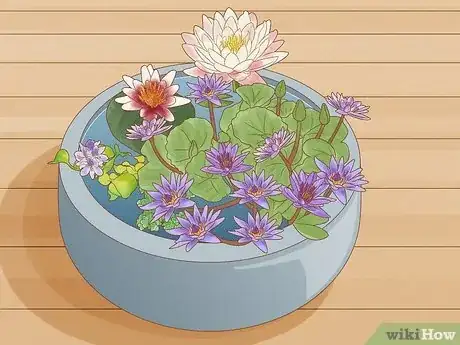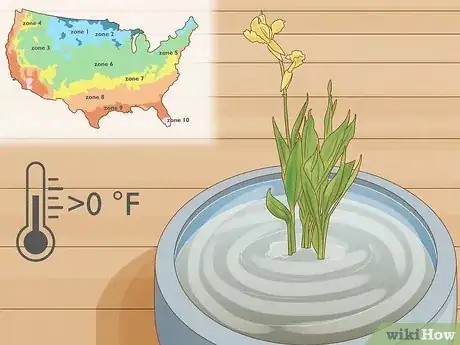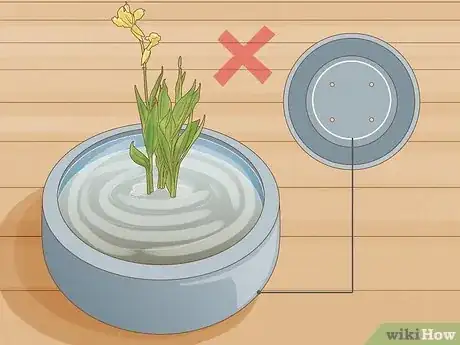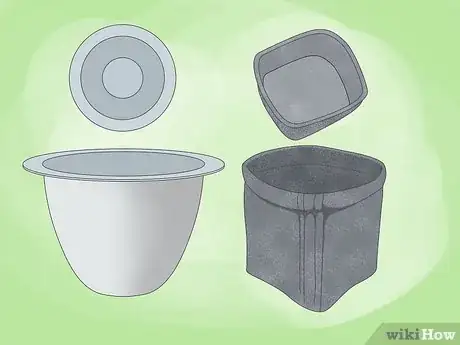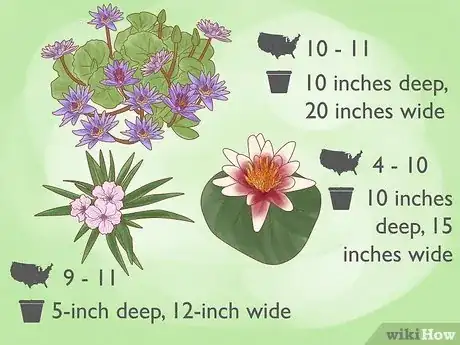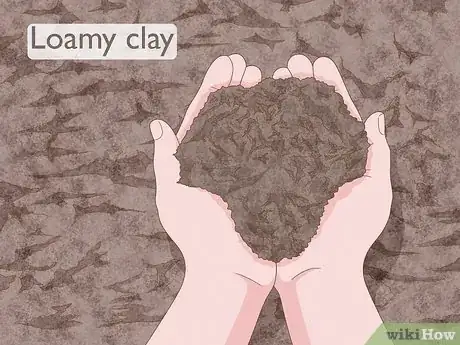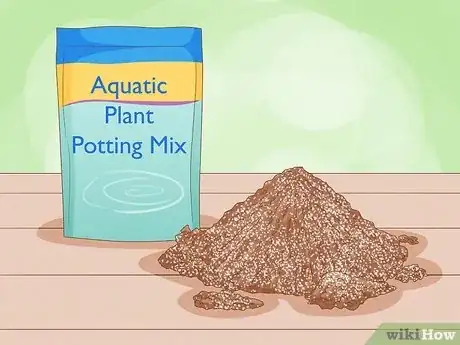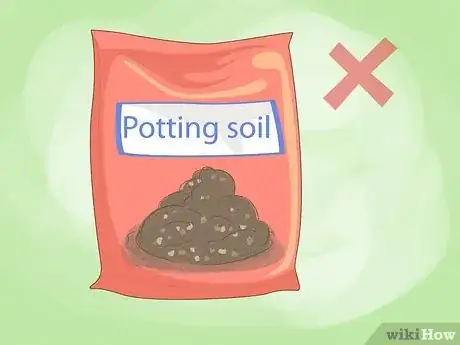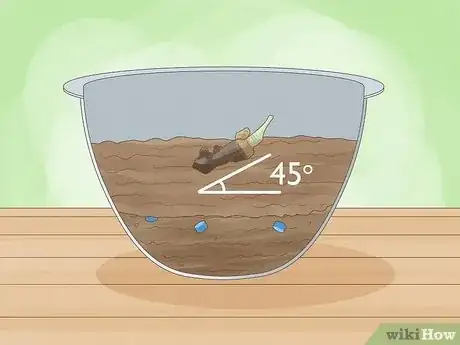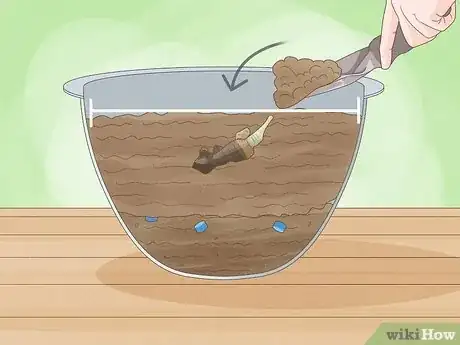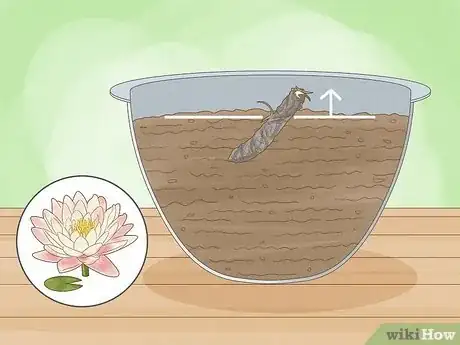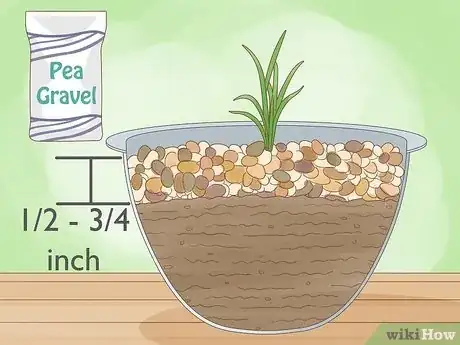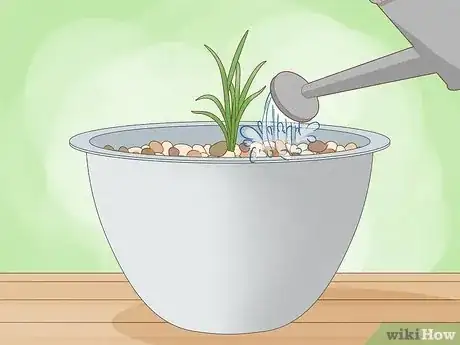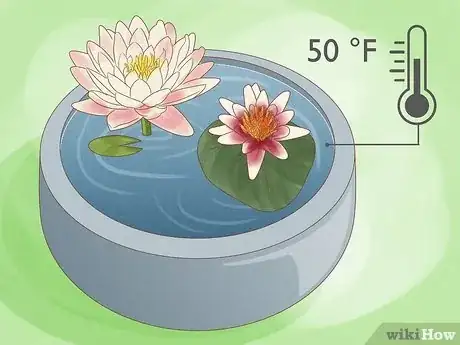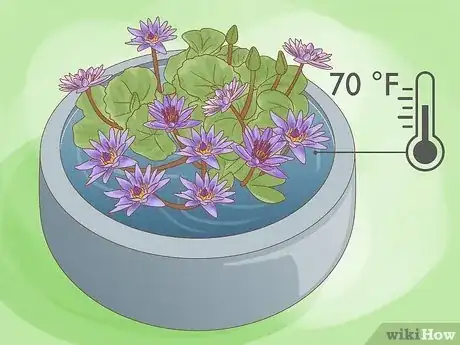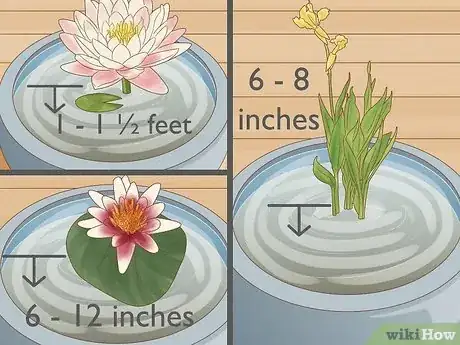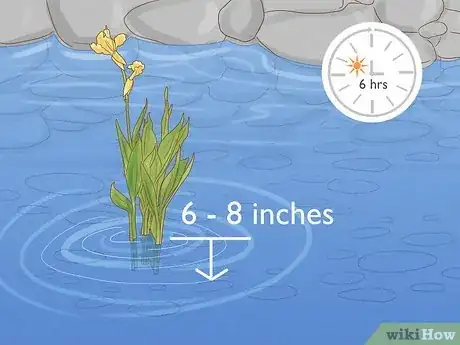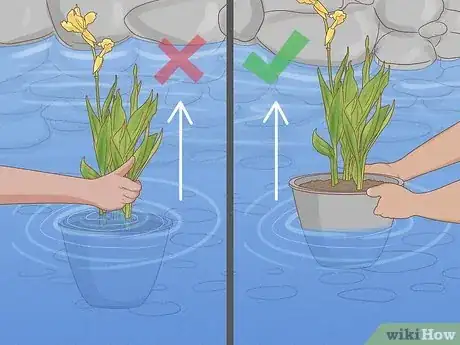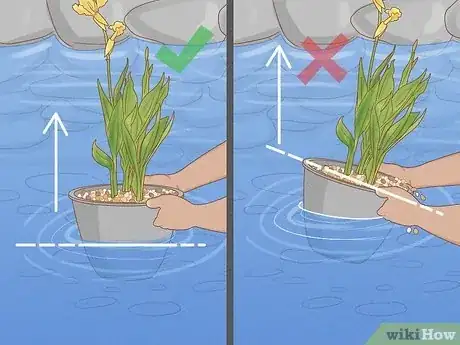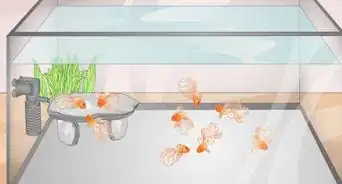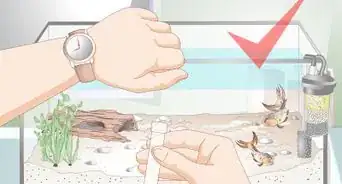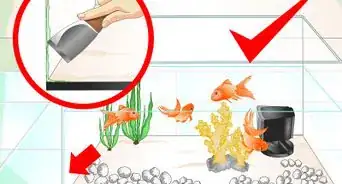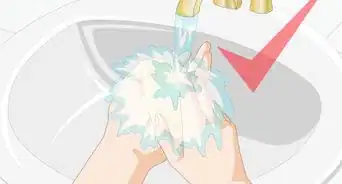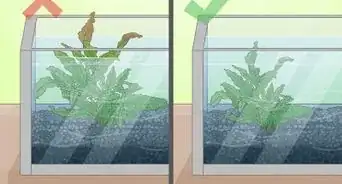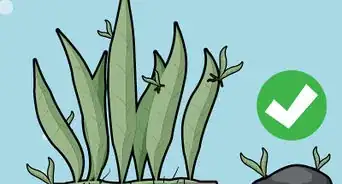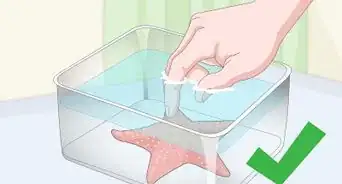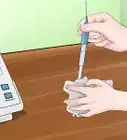wikiHow is a “wiki,” similar to Wikipedia, which means that many of our articles are co-written by multiple authors. To create this article, volunteer authors worked to edit and improve it over time.
There are 9 references cited in this article, which can be found at the bottom of the page.
This article has been viewed 30,337 times.
Learn more...
Aquatic plants do more than just make a water feature more attractive. They also remove nitrogen and phosphorous from the water, which are produced by fish, absorb carbon dioxide and produce oxygen.[1] This makes the environment healthier for the fish and reduces algae as algae requires the same nutrients as larger aquatic plants. When they are planted correctly and get enough light, aquatic plants will grow quickly with healthy foliage and, if the plants bloom, they will usually bloom the first year after planting.
Steps
Part 1: Finding the Right Container
-
1Plant your aquatic plant in a container before putting it in water. Planting it in a container controls its spreading, which many aquatic plants do very quickly.
- Some aquatic plants can completely take over a smaller water feature within a few years and have to be controlled with chemicals or pulled out by hand.
-
2Grow tropical and subtropical water plants like Cannas (Canna spp) in a container. These plants[2] grow well in USDA Hardiness Zones 7 to 10. But they will not survive temperatures below 0 °F (−18 °C).[3]
- If planted in a pond, these plants must be taken out in the fall and stored in a cool, dry area where they will not be exposed to frost during the winter.
Advertisement -
3Do not use a container with drain holes. Unlike terrestrial plants that should be planted in containers with drain holes, aquatic plants do not need a container with holes as the potting soil can wash out through the holes.
-
4Use plastic pots without holes, or fabric pots. Fabric pots are ideal for aquatic plants. The fabric allows water to soak into the potting soil but keeps the soil in and the flexible fabric on the bottom makes it easier to keep the plant level.[4]
- Fabric pots are a bit more expensive than plastic pots, though, and harder to move when the plant is taken out of the water.
-
5Select a container based on how large you want the aquatic pot to grow. Smaller containers keep plants smaller while larger containers let them grow larger. Certain species of aquatic plants also grow better in smaller or larger containers
- Hardy water lilies like the “Comanche” (Nymphaea “Comanche”),[5] which grow well in Zones 4 to 10, and Cannas should be planted in containers that are 10 inches deep and 15 inches wide.
- Tropical water lilies like the “Director George T. Moore” (Nymphaea “Director George T. Moore”)[6] which only grow well in Zones 10 and 11, should be planted in containers that are 10 inches deep and 20 inches wide.
- Smaller plants like the “Katie Ruellia” (Ruellia brittonia “Katie”), which grows to 5 to 10 inches tall and grows well in Zones 9 to 11, can be planted in a 5-inch deep, 8-inch wide pot to keep it them smaller or a 5-inch deep, 12-inch wide pot to let it grow a little larger.
-
6Ask a sales associate at an aquatic plant nursery if you are not sure what size container you should use. They will be able to tell you which size pot will work best for each plant.
Part 2: Using the Right Soil
-
1Use loamy clay for aquatic plants. If the soil in your yard is naturally loamy clay, it can be used for the aquatic plants.
-
2Buy commercially manufactured aquatic plant potting mix if the native soil is sandy or very heavy clay. You can use a brand like PondCare Aquatic Planting Media.[7]
- This mix contains kiln-fired clay pieces, provides plant nutrients and anchors the aquatic plant securely in its container.
- While sandy soil may keep the plant anchored, it will not hold enough nutrients to keep aquatic plants healthy.
-
3Do not use potting soil that is formulated for regular, terrestrial potted plants. It is too light and will leach into the water.
Part 3: Potting Up the Aquatic Plant
-
1If you are planting a rhizome, pour moistened soil into the container until it is ⅓ full. Then, put two to four aquatic plant fertilizer tablets on the soil spaced evenly around the container 2 to 3 inches in from the edge.
- The number of tablets required varies, depending on the size of the tablets and the size of the container.
- There should be 1 to 2 ounces of fertilizer for each gallon of soil.[8]
- Fertilizer tablets with a 12-8-8, 10-6-4, 20-10-5 or 5-10-5 ratio are fine.
-
2Add more damp soil. Do this until the container is ⅔ full.
-
3If you're growing a hardy water lily rhizome, place it at an angle and to one side of the container. These rhizomes are actually thickened stems that resemble sweet potatoes.
- The growing end of the rhizome with growth buds or “eyes” should be placed at the center of the container with the “eyes” facing up and buried deeper than the other end so that the whole thing is sitting at a 45-degree angle.
- The growth buds or “eyes” look very similar to the “eyes” on a potato.
- This placement gives the hardy water lily room to grow in the pot.
-
4Place additional damp soil into the container over the rhizome. The higher end should be just above soil level and the lower end should be covered.
-
5If you're growing tropical water lily and lotus (Nelumbo nucifera) rhizomes, center them in the pot. Their “eyes” should be facing up and the top of the rhizome should be above soil level.[9]
- Lotuses grow well in Zones 4 to 10.
-
6If you're growing Cannas, plant them in the center of the container. Then, cover them with 2 to 3 inches of soil.
-
7For other types of aquatic plants with roots instead of rhizomes, fill the container with ⅔ to ¾ damp soil. Then, hold the plant in the center of the container and add more damp soil until the roots are covered.
-
8Add ½ to ¾ inch of pea gravel over the top of the soil for all aquatic plants. This will help to keep the soil in the container and keep fish from displacing the soil.
-
9Water the aquatic plant right after planting. The soil should be wet.
Part 4: Planting Aquatic Plants in Water
-
1Plant the aquatic plants in the spring or early summer in a water feature that gets at least six hours of sunlight each day. Aquatic plants that get only four hours of sunlight or less will grow very slowly or may not grow at all.
-
2Plant aquatic plants hardy enough to survive cooler temperatures in water that is 50 °F (10 °C). Aquatic plants such as hardy water lilies and lotus do well in these conditions.
-
3Plant tropical and subtropical aquatics in water that is over 70 °F (21 °C). Cannas and tropical water lilies will do well in these conditions.
-
4Place them in a spot where there is no more than 6 to 8 inches of water above the pot. This will then allow sunlight to easily reach them. Bricks or overturned clay pots can be placed beneath the aquatic plant container to raise it up if the water is too deep.
- Deeper water will not let the sunlight reach the plant rhizomes or roots to trigger new stem growth.
- Hardy water lilies grow best with 1 to 1 ½ feet of water covering the container.
- Tropical water lilies do fine with 6 to 12 inches of water over the container but lotus grow in 4 to 6 inches of water.[10]
- Cannas grow well up above the water.[11] They should be placed so that the top of the container is 6 to 8 inches deep.
-
5If the pond gets only six hours of sunlight each day, place them at a depth of 6 inches. Adjust this to 6 to 8 inches if the pond gets more than six hours of sunlight.
- Lotus should be submerged to a depth of only 2 inches until they begin to grow.
- After the aquatic plants reach 4 to 6 inches tall, they can be moved into deeper water.
-
6Do not lift the plant by its stems. They will break. Instead, lift the container by grasping it at the top with one hand on either side to hold it level or grasp it at the top on one side, tilt it just enough to get a hand underneath and move it with one hand on the bottom and one hand at the top of the container.
-
7Keep the container as level as possible when moving it. This will keep the gravel from spilling over the side of the container.
Community Q&A
-
QuestionWhich plant are best to grow in aquariums?
 Gini PugCommunity AnswerEasy to grow plants include hornwort and water wisteria. You could either anchor them in substrate, or leave them floating at the surface. They will be fine either way. You can also cut of pieces of these plants and they will grow a new plant.
Gini PugCommunity AnswerEasy to grow plants include hornwort and water wisteria. You could either anchor them in substrate, or leave them floating at the surface. They will be fine either way. You can also cut of pieces of these plants and they will grow a new plant.
Warnings
- Only some plants can be fully submerged. Check to make sure, otherwise, the plant will rot.⧼thumbs_response⧽
References
- ↑ http://www.clemson.edu/extension/hgic/plants/other/landscaping/hgic1709.html
- ↑ http://www.missouribotanicalgarden.org/PlantFinder/PlantFinderDetails.aspx?taxonid=265515&isprofile=0&
- ↑ http://planthardiness.ars.usda.gov/PHZMWeb/#
- ↑ http://www.watergarden.org/Potting-Plants
- ↑ http://www.missouribotanicalgarden.org/PlantFinder/PlantFinderDetails.aspx?taxonid=250787&isprofile=1&gen=Nymphaea
- ↑ http://www.missouribotanicalgarden.org/PlantFinder/PlantFinderDetails.aspx?taxonid=250788&isprofile=1&gen=Nymphaea
- ↑ http://www.watergarden.org/Potting-Plants
- ↑ http://www.watergarden.org/Aquatic-Plant-Care
- ↑ http://www.missouribotanicalgarden.org/PlantFinder/PlantFinderDetails.aspx?taxonid=255132&isprofile=0&chr=48
